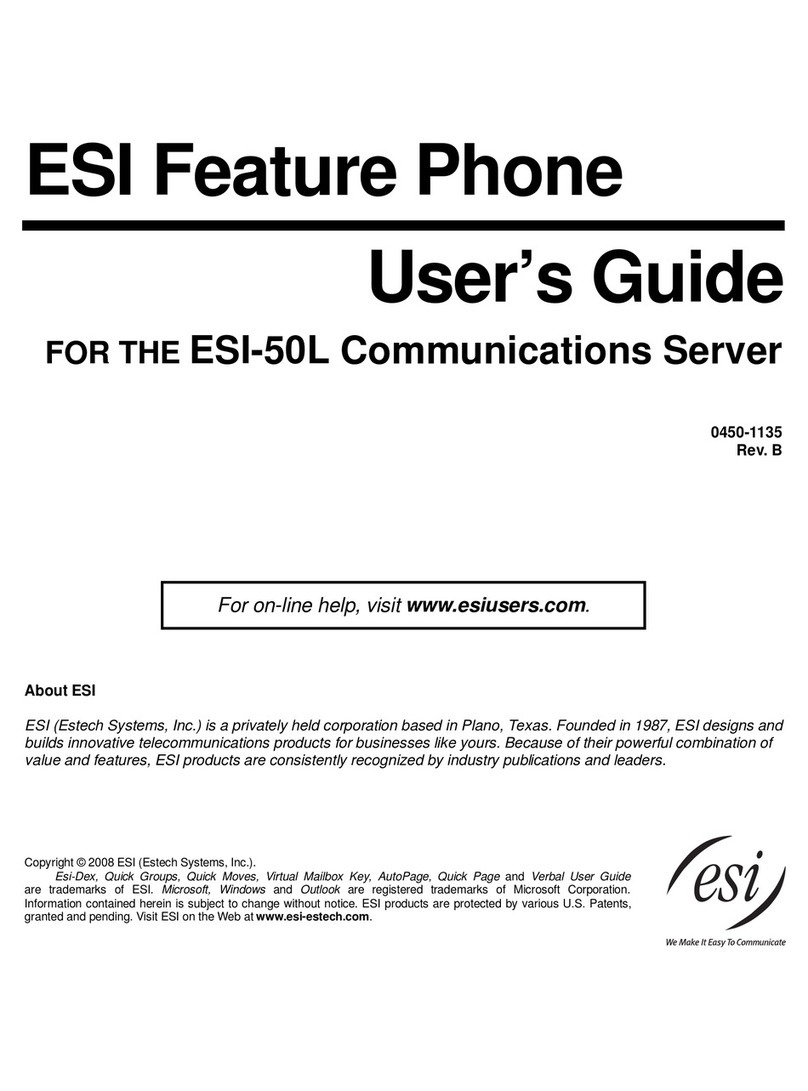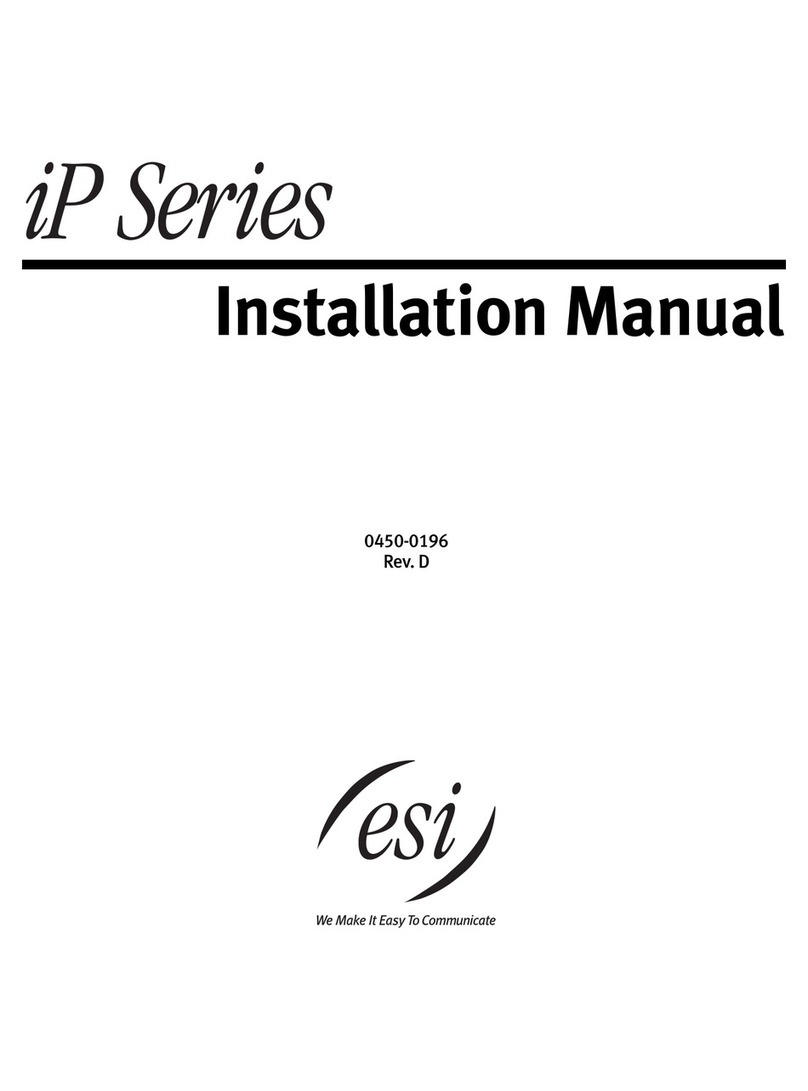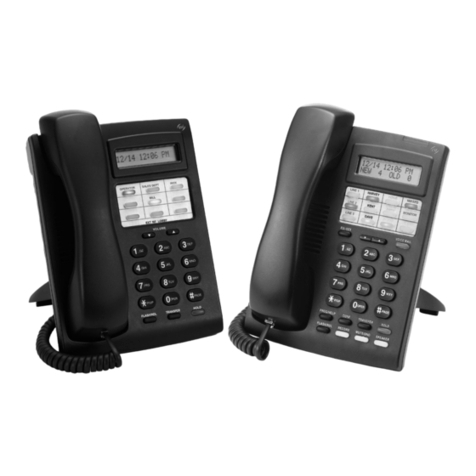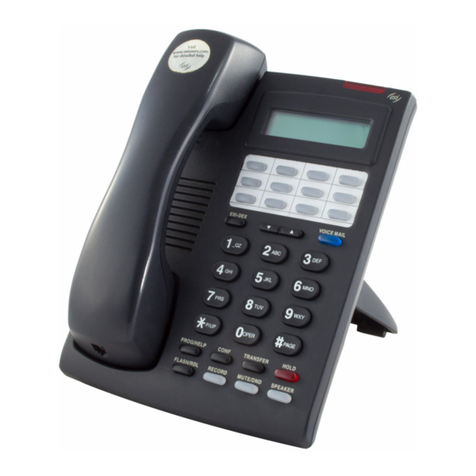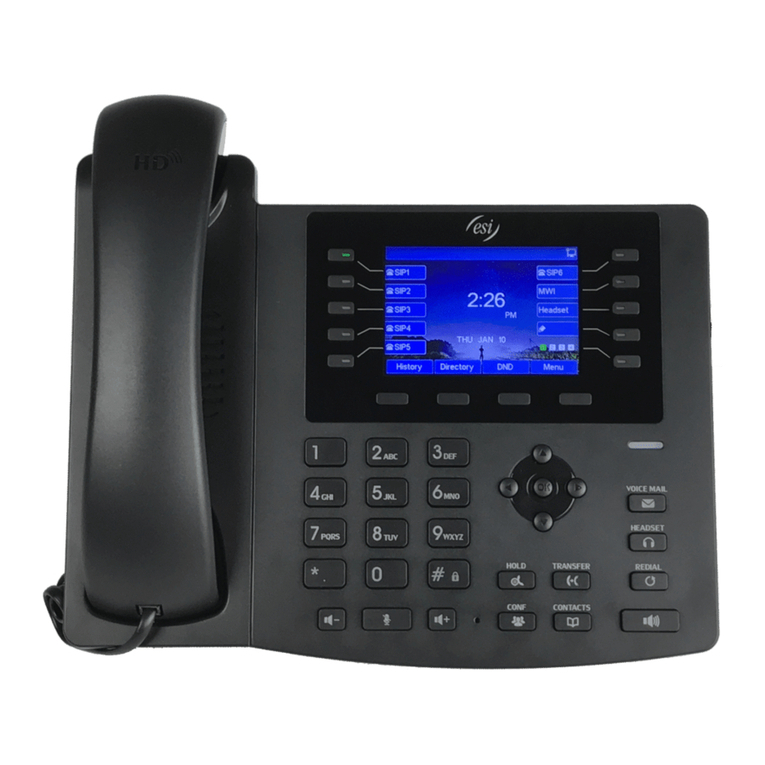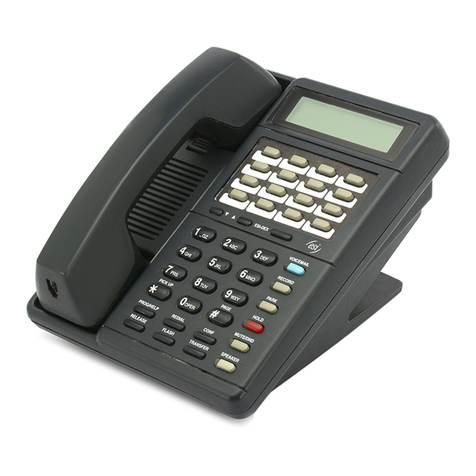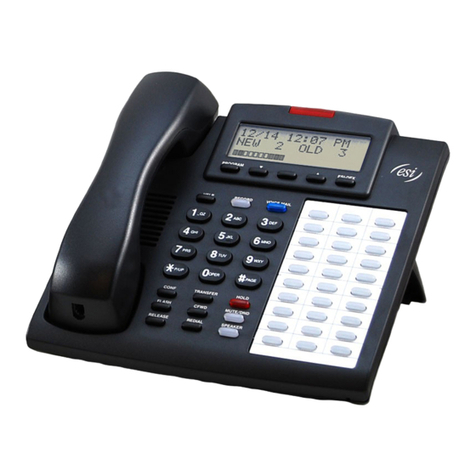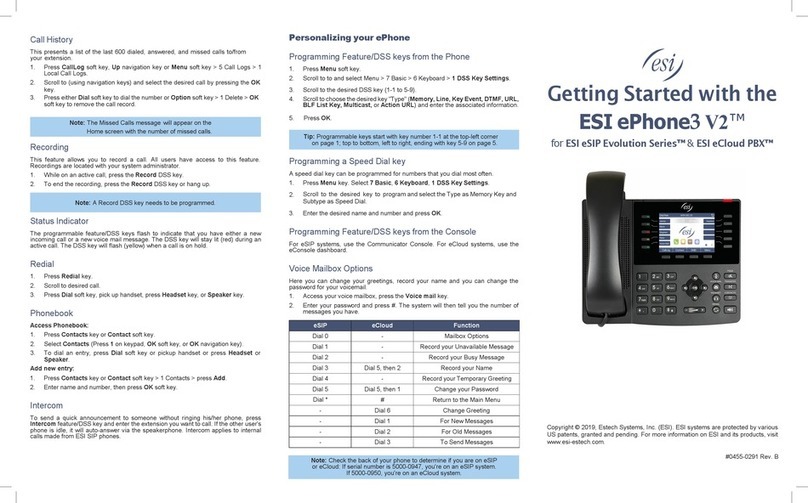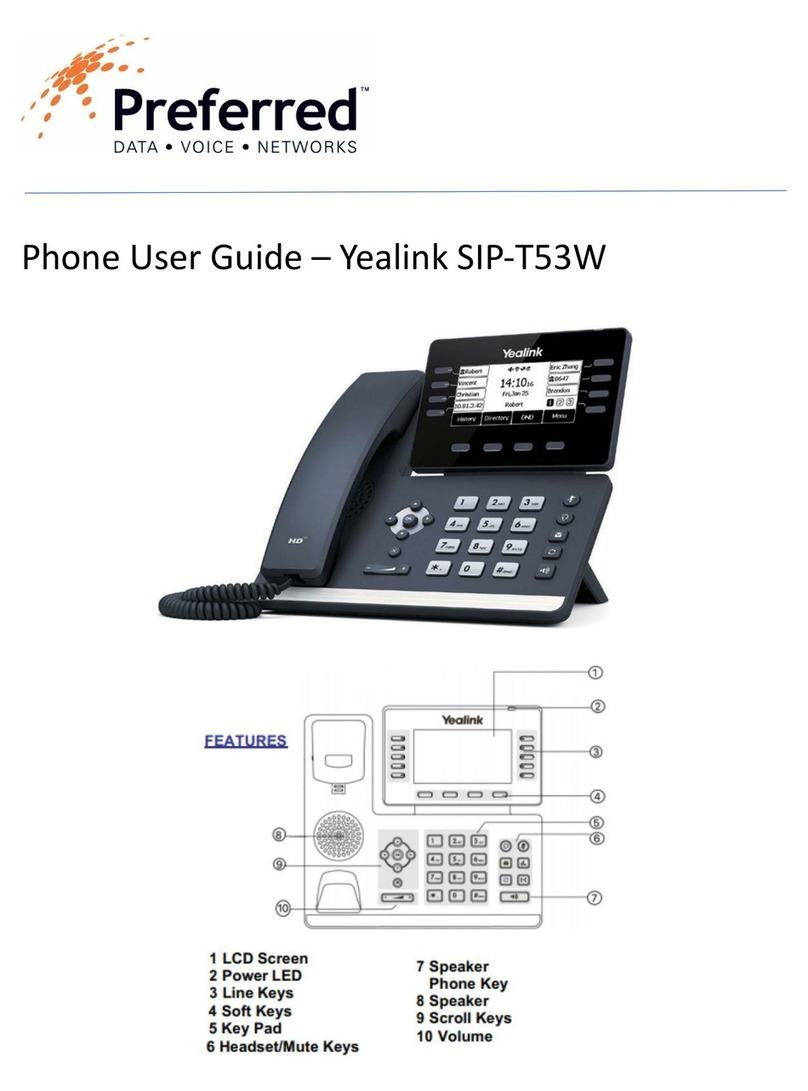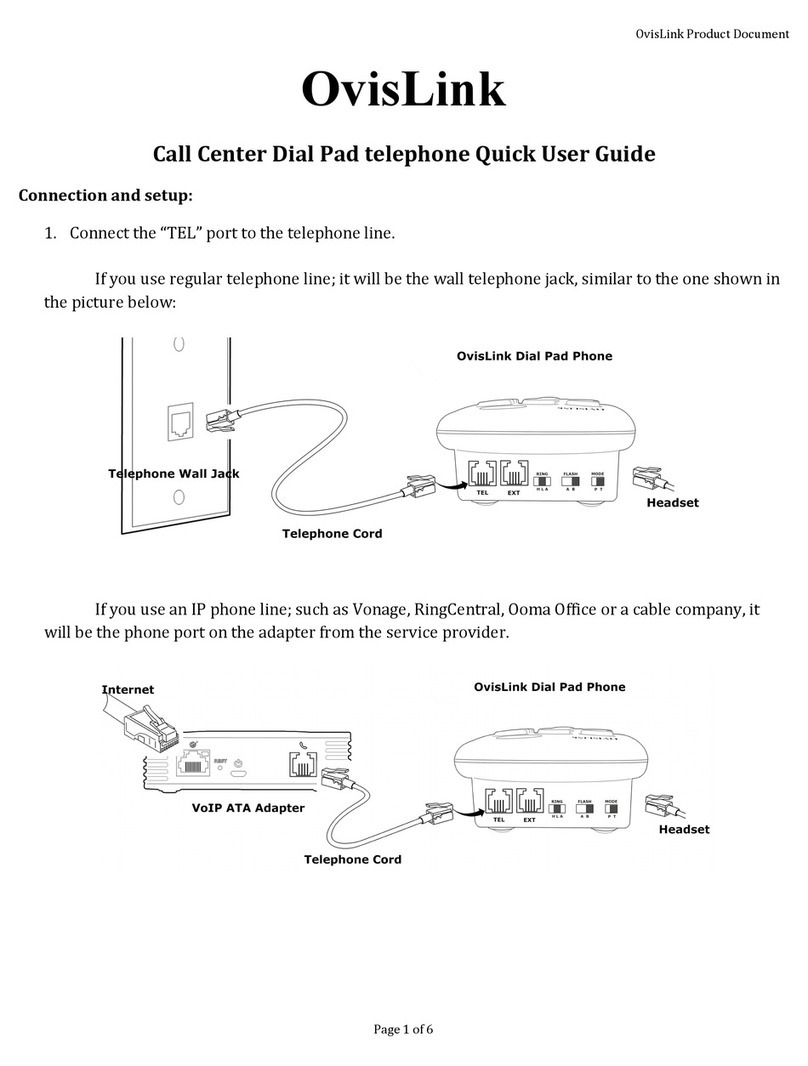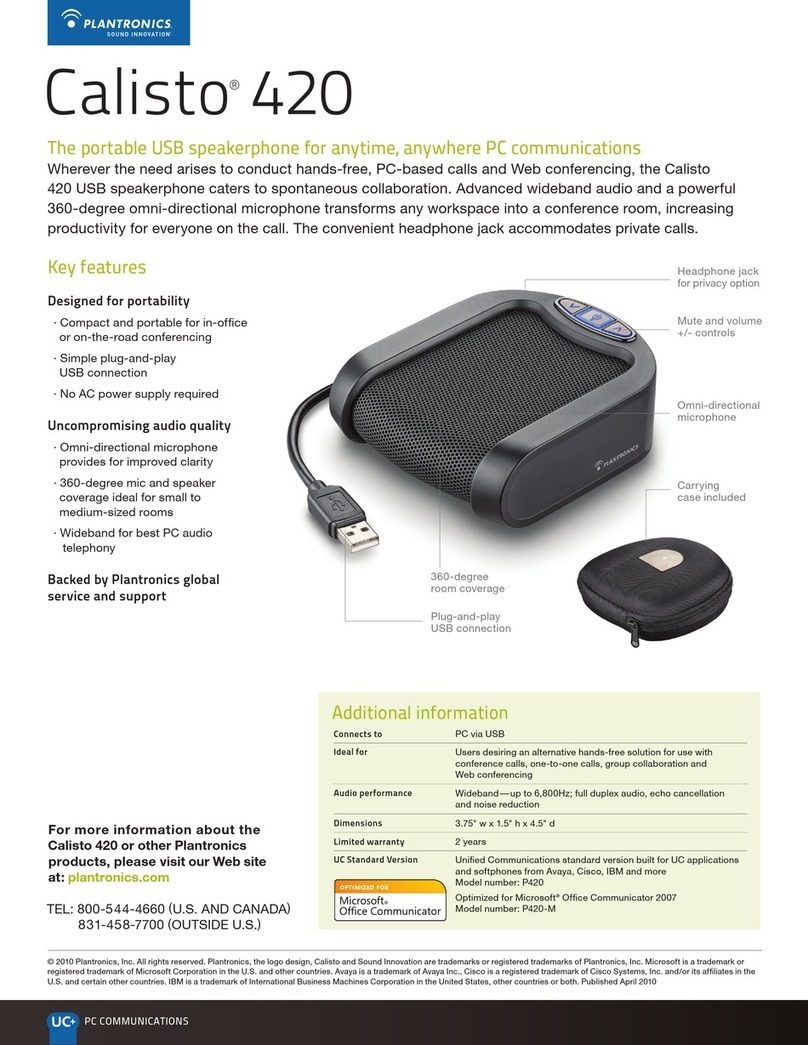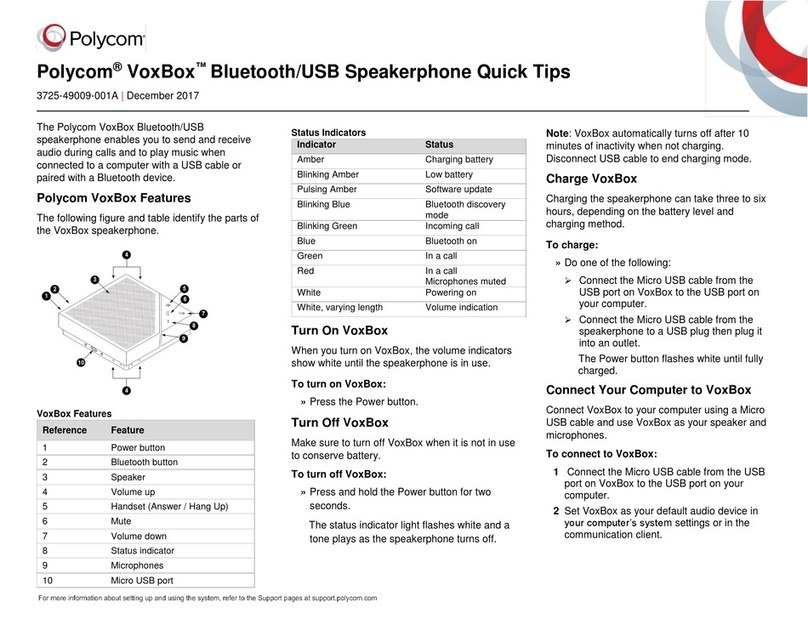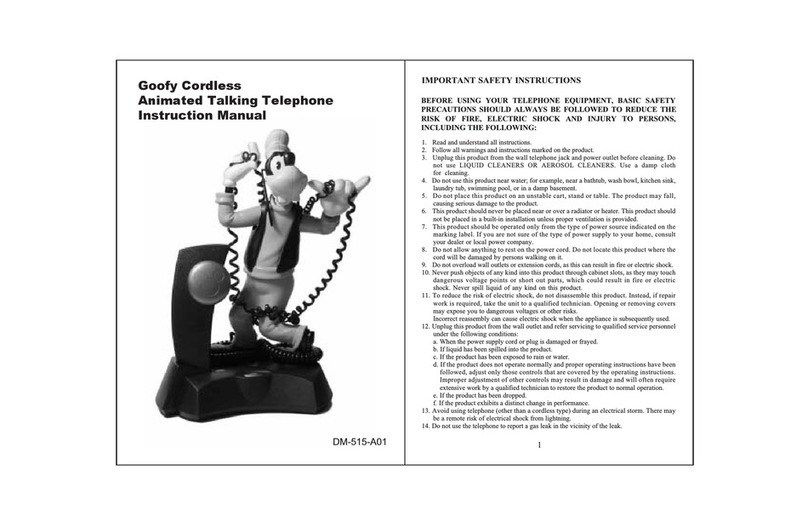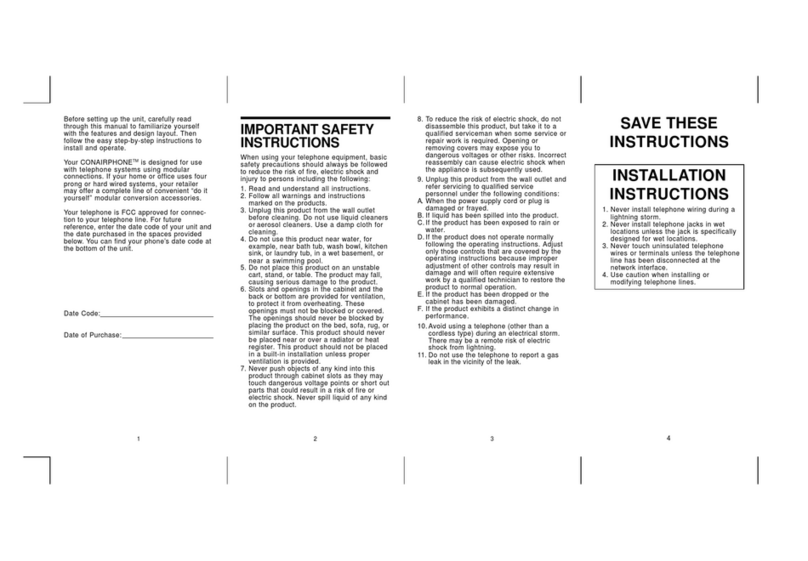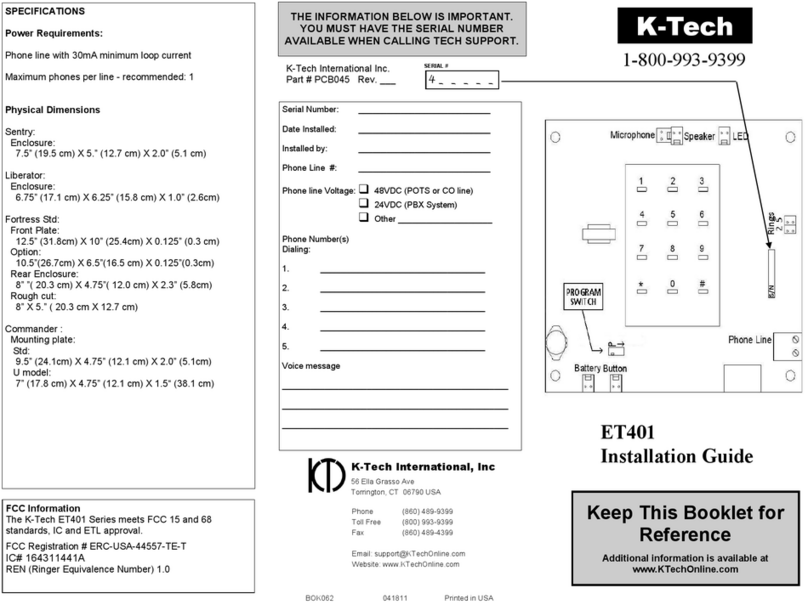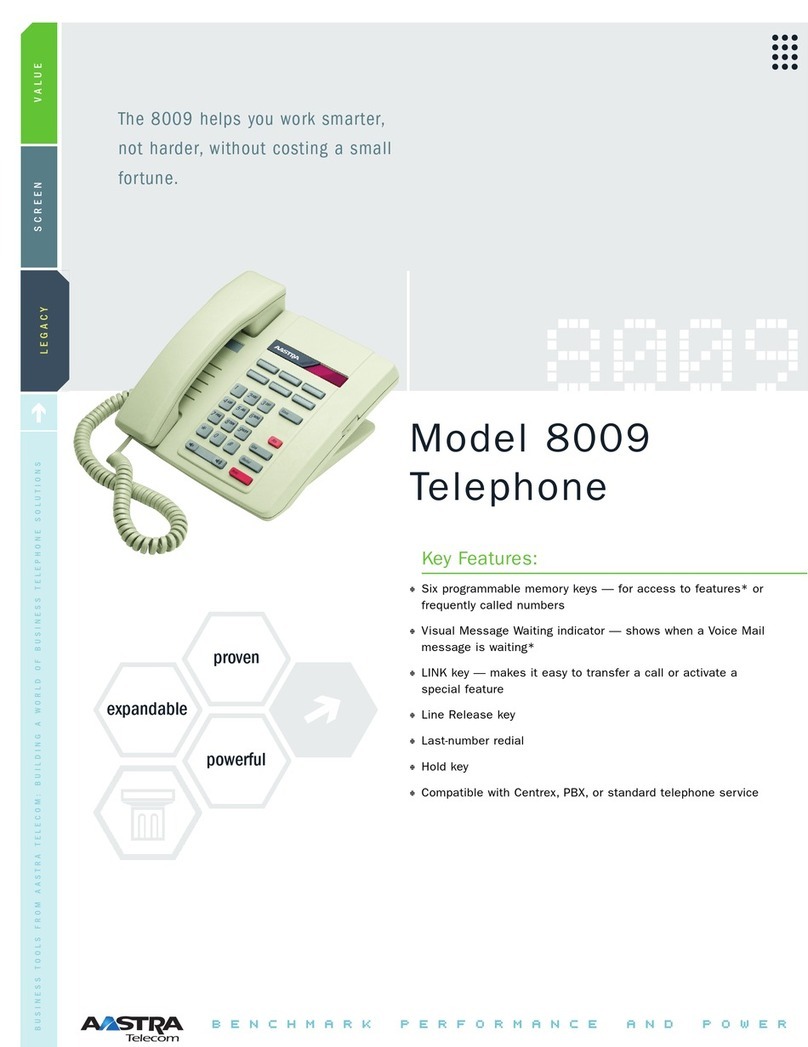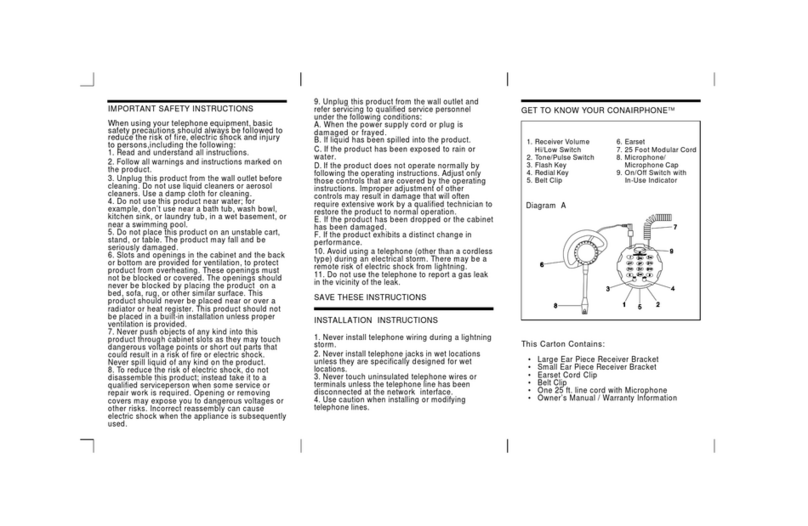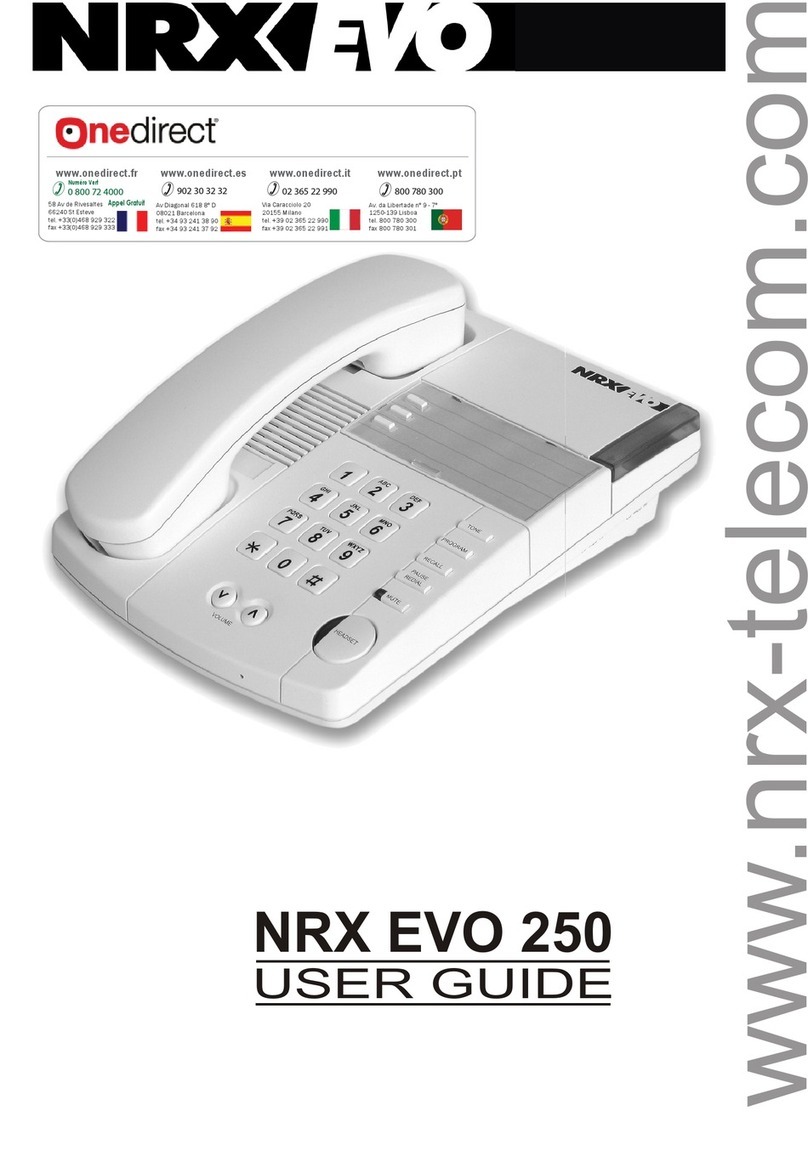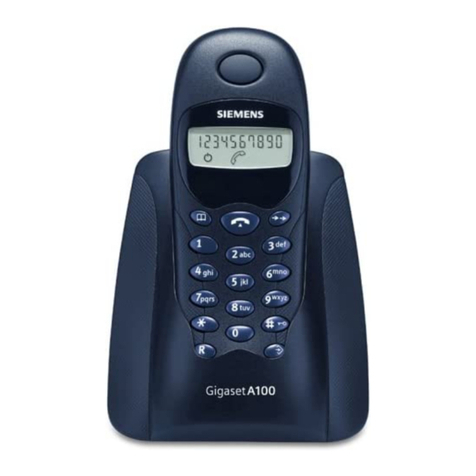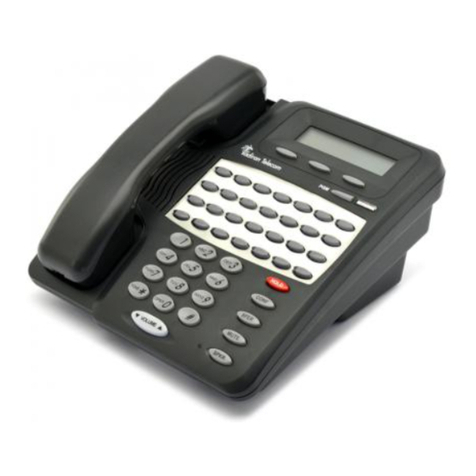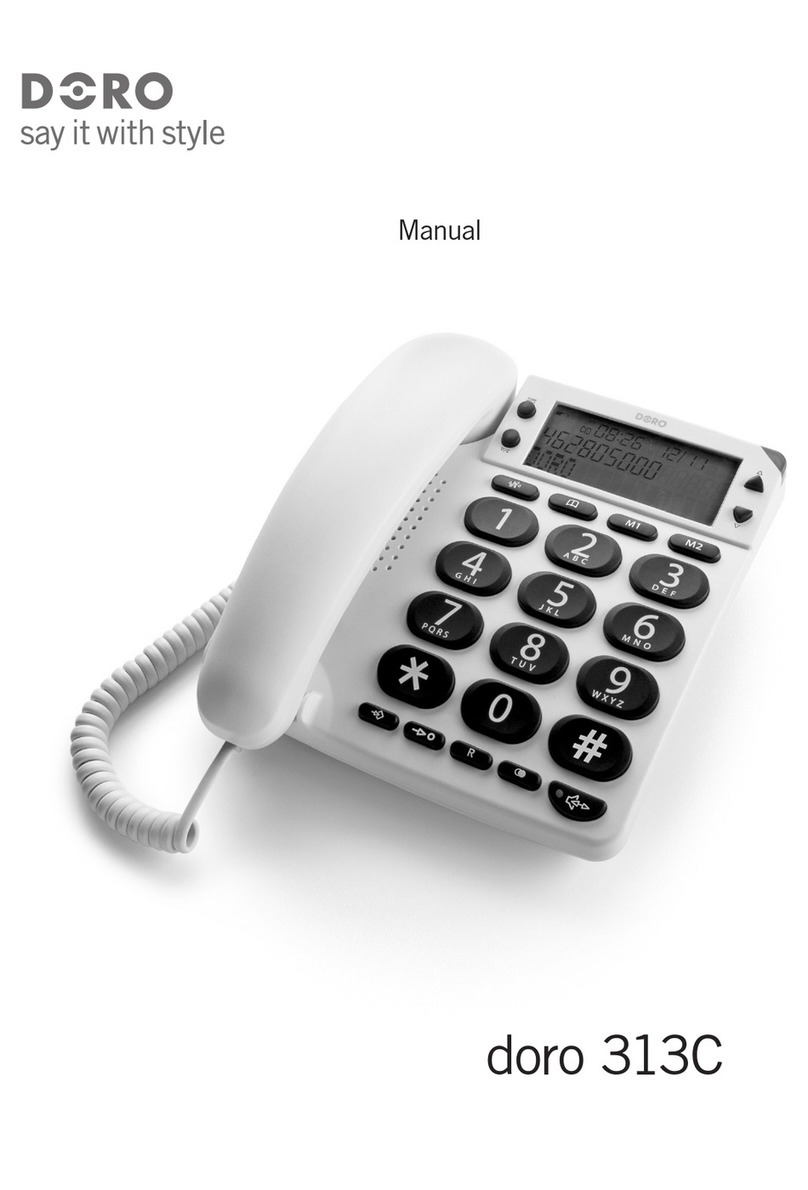ESI 48-Key Feature Phone User manual

ESI Feature Phone
User’s Guide
FOR
WITH Integrated Answering Machine
0450-0484
Rev. E
Visit http://www.esiusers.com for up-to-date help.

About ESI
ESI (Estech Systems, Inc.) is a privately held corporation based in Plano, Texas. Founded in 1987, ESI
designs and builds innovative telecommunications products for businesses like yours. Because of their
powerful combination of value and features, ESI products are consistently recognized by industry
publications and leaders.
Copyright © 2005 ESI (Estech Systems, Inc.).
IVX is a registered trademark, and Esi-Dex, Integrated Answering Machine, Quick Groups, Quick Moves, Virtual Mailbox Key,
AutoPage, Quick Page and Verbal User Guide are trademarks, of ESI. CompactFlash is a registered trademark of SanDisk
Corporation. Act! is a registered trademark of Symantec Corporation. Goldmine is a trademark of Goldmine Software Corporation.
Microsoft, Windows, NT and Outlook are registered trademarks of Microsoft Corporation. Panasonic and DBS are registered
trademarks of Matsushita Electric Corporation of America.
Information contained herein is subject to change without notice.
ESI products are protected by various U.S. Patents, granted and pending.
ESI is an ISO 9001-certified company. Visit ESI on the Web at www.esi-estech.com.

Table of contents
Introduction...............................................................................................................................................................A.1
What it covers...............................................................................................................................................................................................A.1
How it’s arranged .........................................................................................................................................................................................A.1
48-Key Feature Phone ................................................................................................................................................................................A.2
24-Key Feature Phone ................................................................................................................................................................................A.4
12-Key Feature Phone ................................................................................................................................................................................A.5
Connecting your ESI phone........................................................................................................................................................................A.6
Help mode (Verbal User’s Guide)...........................................................................................................................B.1
User programming: An introduction......................................................................................................................C.1
User programming menu ............................................................................................................................................................................C.1
Integrated Answering Machine operation.............................................................................................................D.1
Introduction ...................................................................................................................................................................................................D.1
Greetings.......................................................................................................................................................................................................D.1
Leaving messages . . ..................................................................................................................................................................................D.2
Off-premises “reach me”..............................................................................................................................................................................D.2
Message retrieval.........................................................................................................................................................................................D.2
Off-premises message delivery ..................................................................................................................................................................D.5
Message Recycle Bin (un-delete)...............................................................................................................................................................D.6
Status Indicator lamp ...................................................................................................................................................................................D.6
ESI Feature Phone operation..................................................................................................................................E.1
Display...........................................................................................................................................................................................................E.1
Caller ID ........................................................................................................................................................................................................E.1
Keys...............................................................................................................................................................................................................E.1
Dial tone........................................................................................................................................................................................................E.3
Basic phone use...........................................................................................................................................................................................E.3
Direct station selection.................................................................................................................................................................................E.4
Transferring an outside call . . ....................................................................................................................................................................E.5
Conferencecalling .......................................................................................................................................................................................E.6
Call forwarding..............................................................................................................................................................................................E.6
Call waiting....................................................................................................................................................................................................E.7
Hold/exclusive hold operation .....................................................................................................................................................................E.8
Paging.........................................................................................................................................................................................................E.10
Call pickup...................................................................................................................................................................................................E.10
Optional feature..........................................................................................................................................................................................E.10
Special keys..............................................................................................................................................................F.1
FLASH, REDIAL, RELEASE......................................................................................................................................................................F.1
Esi-Dex..........................................................................................................................................................................................................F.2
Override ring.................................................................................................................................................................................................F.9
Message monitor mode (live call screening) ...........................................................................................................................................F.10
Greeting reminder......................................................................................................................................................................................F.10
Headset operation......................................................................................................................................................................................F.10
Outside dial tone preference.....................................................................................................................................................................F.11
Line keys.....................................................................................................................................................................................................F.11
Optional features........................................................................................................................................................................................F.12
Analog stations........................................................................................................................................................ G.1
Placing calls.................................................................................................................................................................................................G.1
Transferring calls.........................................................................................................................................................................................G.1
Call forwarding.............................................................................................................................................................................................G.2
Call waiting...................................................................................................................................................................................................G.2
Call hold .......................................................................................................................................................................................................G.2
Paging..........................................................................................................................................................................................................G.2
Call pick-up..................................................................................................................................................................................................G.3
Voice mail operation from an analog station.............................................................................................................................................G.3
Analog station programming......................................................................................................................................................................G.5
Select greeting (Master Station user only)................................................................................................................................................G.5
Password.....................................................................................................................................................................................................G.5
Off-premises message delivery .................................................................................................................................................................G.6
Message Recycle Bin (un-delete)..............................................................................................................................................................G.7

(This page included for pagination purposes only.)

User’s Guide Introduction
A.1
Introduction
Accessing the rich ESI feature set is simple and easy through the straightforward design of ESI Feature
Phones. Each feature has been designed for ease of use while providing capabilities needed in an
advanced business phone.As for the IVX S-Class phone system itself, its Integrated Answering
Machine™functions like a traditional answering machine but with additional,special features.
You’ll be able to learn many of the features simply by using your phone; and this User’s Guide will
introduce you to the wide variety of features offered by your ESI phone system and how to use your
phone effectively to achieve maximum benefits.
What it covers
• 48-Key Feature Phone
• 24-Key Feature Phone
• 12-Key Feature Phone
• 60-Key Expansion Console (for use with only the 48-Key Feature Phone)
How it’s arranged
• Section A— Introduction and Phone Illustrations
• Section B — User help
• Section C — User programming
• Section D — Integrated Answering Machine operation
• Section E — Phone operation
• Section F — Special keys and features
• Section G — Analog Stations
• Index

Introduction User’s Guide
A.2
48-Key Feature Phone
The 48-Key Feature Phone has a variety of programmable and built-in features. Additionally, it
supports the optional 60-Key Expansion Console.The 48-Key Feature Phone’s built-in voice mail
features and voice prompts make it easy to program and use.
Hint: On any of these phone varieties (including the 60-Key Expansion Console), you can perform direct
programming by holding down a programmable feature key for at least two seconds (similar to how you
mightprogram a car radio button). This isn’t applicable to the fixed feature keys which, as their name
implies, are already programmed.
3-line, 56-character display
ESI-DEX
feature key
(pg. F.2)
PROGRAM
feature key
(pg. C.2)
Volume/scroll keys
(pg. E.2)
30 programmable
feature keys
(pg. C.2)
Microphone for
built-in speakerphone
Fixed feature keys
(pg. E.1)
Status indicator
lamp (pg. D.6)
VOICE MAIL
key (pg. D.1)
HELP key for
access to Verbal
User Guide
and tutorial
(pg. B.1)
RECORD key
Context-specific
key to select
displayed options
PAGE key
(pg.E.10)
P/UP
(pickup) key
(pg. E.10)
Speaker

User’s Guide Introduction
A.3
Optional 60-Key Expansion Console for use with the 48-Key Feature Phone
The 60-Key Expansion Console adds 60 more programmable feature keys to your 48-Key Feature Phone.
You program the Expansion Console’s keys just as you do the programmable feature keys on your ESI
Feature Phone, using either direct or traditional programming (see pages C.2).
Note: Only one key can exist perextension, feature or operation. If you program a second key for the same
extension, feature or operation, this automatically erases the first key so programmed, thus making it
available for a new extension, feature oroperation.
Hint: You may find iteasier to write in the names on the overlay before you program the keys and attach the
overlay to the Console.
Hint: On any of these phone varieties (including the 60-Key Expansion Console), you can perform direct
programming by holding down a programmable feature key for at least two seconds (similar to how you
mightprogram a car radio button). This isn’t applicable to the fixed feature keys which, as their name
implies, are already programmed.
60 programmable
feature keys
(pg. C.2)
in two banks
of 30 each

Introduction User’s Guide
A.4
24-Key Feature Phone
The 24-Key Feature Phone has a variety of programmable and built-in features. The 24-Key Feature
Phone’s built-in voice mail features and voice prompts make it easy to program and use.
Hint: You can perform direct programming by holding down a programmable feature key forat least two
seconds (similarto how you mightprogram a carradio button).This isn’t applicable to the fixed feature
keys which, as their name implies, are already programmed.
2-line, 32-character display
ESI-DEX feature key
(pg. F.2)
PROG/HELP
feature key
for phone programming
as well as access
to Verbal User’s Guide
and tutorial (pg. B.1)
Volume/scroll keys (pg. E.2)
12 programmable feature keys
(pg. C.2)
Microphone for
built-in speakerphone
Speaker
Fxed feature keys
(pg. E.1)
VOICE MAIL feature key
(pg. D.1)
RECORD fixed feature key
Status indicator light (pg. D.6)
PAGE key (pg. E.10)
P/UP (pickup) key
(pg. E.10)

User’s Guide Introduction
A.5
12-Key Feature Phone
The 12-Key Feature Phone includes the basic, most commonly used phone features.
Note: Certain special features, including Esi-Dex (see “Special keys,” pages F.1–F.13), are not available on
the 12-Key Feature Phone.
Important: A VOICE MAIL key, CONFERENCE key, and MUTE/DND key must be set on one of the nine
programmable feature keys to utilize those features.
Hint: You can perform direct programming by holding down a programmable feature key forat least two
seconds (similarto how you mightprogram a carradio button).This isn’t applicable to the fixed feature
keys which, as their name implies, are already programmed.
1-line,
16-character display
Volume/scroll keys (pg. E.2)
9 programmable
feature keys
Speaker
Fixed feature keys
PAGE key (pg. E.10)
P/UP (pickup) key
(pg. E.10)
PROG/HELP
combo fixed feature key
for phone programming
as well as access
to Verbal User’s Guide
and tutorial

Introduction User’s Guide
A.6
Connecting your ESI phone
Use the diagram (below) to connect your ESI phone. Each diagram represents the panel on the
phone’s underside.
Note: The “Top of phone” and “Bottom of phone” references in this diagram shows the correct vertical
orientation of the phone — i.e., the part with the display is the top.
12-Key Feature Phone
24-Key Feature Phone
• Connects like a basic phone.
• Handset plugs into right-side jack.
• Line cord plugs into left-side jack.
48-Key Digital Feature Phone
In addition to how the 24-Key Feature Phone connects
to the handset and line cord, note the following:
• Headset jack.1
• TAPI version includes a cable for connecting to your
PC’s serial port.
• 60-Key Expansion Console cable (included with each
Console) uses standard RJ-11 telephone connectors.
Note: Use the wall mount hook (located under the handset) when the phone is in the furthest upright position.
1If shipped after March 1, 2004.
Line cord
to wall
Handset
Line cord
to wall
(TAPI)
To PC
To 60-Key
Console
Handset
[Headset
jack]

User’s Guide Help mode (Verbal User Guide)
B.1
Help mode (Verbal User’s Guide)
Your ESI phone system’s help mode (also called the Verbal User Guide) — a carefully conceived
combination of spoken information, display readouts and even key illumination when appropriate — is a
powerful tool to help you learn how to use the system’s many features.
Tutorial
When your station is idle, press HELP, and then follow the spoken help menu to:
• Learn how to use the phone • Hear a description of how any key is used
• Learn how to use voice mail features • Hear a complete tutorial on phone operation
Help during station programming
To hear a detailed description of a function you wish to program, press HELP while programming it.
Help during a call
Press HELP while on a call and this will place the call on hold, whereupon you can use help mode to
hear a description of the function you wish to perform. When you exit help mode, you will be
reconnected to the call.
While you are either in help mode or programming your phone, your station will be temporarily placed in
DND (see “MUTE/DND,” page E.2). Anyone calling your station while you are in DND will be forwarded
to the Integrated Answering Machine (or other destination set by the Installer).
Exiting help mode
To exit help mode, simply hang up.
Visit www.esiusers.com for up-to-date help.

Help mode (Verbal User Guide) User’s Guide
B.2
(This page included for pagination purposes only.)

User’s Guide User programming: An introduction
C.1
User programming: An introduction
The answering machine can record up to two simultaneous calls. When a message is left, the
VOICE MAIL key on the 12, 24, or 48-Key Feature Phone will light. Messages can be retrieved by
any authorized 12, 24, or 48-Key Feature Phone or remotely from an off-premises location. Only one
user can access the mailbox at a time. The system can also be programmed to call an off-premises
number to deliver messages.
The first member in the Master List is allowed to program the Integrated Answering Machine via the
PROGRAM key. This station is designated as the Master Station. All other users will only be able to
play and delete messages. A 12, 24, or 48-Key Feature Phone can be installed on an extension in the
Master Lst. However, a 24 or 48-Key Feature Phone must be on the extension designated as the
Master Station.
Voice prompts will play menu and sub-menu options to access the desired feature. You don't have to wait
for the entire prompt to be played. Therefore, once you’ve become familiar with the prompts (consult
“User programming menu,” below), you can quickly set any frequently used feature.
Programming help
During any of the programming steps, press HELP to hear a more detailed description of the feature
and related programming options.
Exiting programming mode
To exit programming mode, simply hang up.
User programming menu
Overview
Note: Only menu options 2, 3, and 4 (except for personal greeting reminder) are available to non-Master users.
1 Select personal greeting
1 Record
2 Delete
3 Hear
2 Programmable feature keys
(Station keys, line keys, speed-dial keys, other
feature keys)
3 Station options
1 Call waiting/background announce
2 Personal greeting reminder
3 Headset operation1
4 Outside dial tone preference
5 Hands-free answer
6 Message monitor
4 Station audibles
1 Station ring tone
2 Station ring volume
3 Message ring
5 Password
1 Enter
2 Delete
3 Hear
4 Security level
6 External message notification
1 Delivery options
2 Phone delivery
3 Pager notification
9 Un-delete
Note: Background announce and selections 3, 5, and 6 understation options are not available on a 12-Key
Feature Phone.
1Not necessary with Generation II system. If unsure which system you have, consult your System Administration.

User programming: An introduction User’s Guide
C.2
1 Select personal greeting
Select the desired greeting — 1, 2 or 3. The system will play the current greeting, followed by
prompts to re-record, delete or hear again — or select the current greeting by pressing #.
1 Record personal greeting
Begin recording at the tone. Press 1to stop. The new personal greeting automatically replaces
the previous greeting.
2 Delete personal greeting
When prompted, press 2again to confirm deletion.
Warning: The mailbox is disabled if no greeting exists. Never delete all of the existing greetings
before you record at least one new one.
3 Hear current personal greeting
2 Programmable feature keys
There are two methods for programming your phone:
• Direct programming — Select the key you want to program, and hold it down for at least two
seconds.This not only initiates programming but also lets you immediately program that specific key.
Direct programming example:
You wish to set one of the keys to dial a co-worker, whose extension is 105. Hold down the
key for at least two seconds. This automatically puts you in feature key programming.
Follow the prompts to enter 1 0 5. (This has allowed you to skip two steps — pressing
PROGRAM and selecting a menu option — that you’d have had to perform if using
traditional programming.)
• Traditional programming — Press PROGRAM. The Verbal User’s Guide will speak to you,
walking you through the full menu, during which you can choose the appropriate option.
How the programmable feature keys can be set
• Line keys — If a line number (1 through 12) is programmed, the programmable feature key
becomes a line key providing the appropriate lamp information and manual outside-line access.
• Station keys — If the dialed digits input are a three-digit number, the programmable feature key
will become a station key, providing the appropriate lamp information and easy access or
transfer. Three-digit numbers you enter can be:
— User extensions (100–123 and 124–129)
— Department numbers (290–299)
— System speed-dial numbers (600–699)
• Speed-dial keys — In addition to programming a programmable feature key with a system
speed-dial number, you can create personal speed-dial keys for automatic dialing of frequently
called outside numbers. If you program 9(or 8or 7) plus a phone number, the programmable
feature key becomes a speed-dial key. When you program a speed-dial key, there's no need to
insert a pause after the 9(or 8or 7).The speed-dial number can be up to 24 characters long.
Use the up scroll key () to enter special characters in a dial string (see Option 6 on page C.4).
• Other feature keys — If you enter feature codes, the programmable feature key will serve as an
enable/disable key for that feature. The Installer may have programmed certain stations for
accessing additional features; consult your System Administrator for your access (see page F.12).

User’s Guide User programming: An introduction
C.3
Keys’ LED activity during programming
Key type and LED indication
Mode Station key or
Virtual Mailbox Key
Line key Feature key
or speed-dial key
Currently being programmed and
previously assigned Flashing red Flashing green Flashing amber
Currently being programmed and
previously unassigned Flashing red Flashing red Flashing red
Programming mode — Was assigned or
viewed in current session Blinking red Blinking green Blinking amber
A
ssigned in a previous programming session
and not yet viewed in current session Solid red Solid green Solid amber
Never assigned and not yet viewed in current
session Off Off Off
3 Station options
The station options sub-menu (PROGRAM 3) lets you activate or deactivate several features your
station can provide.At each option sub-menu, 1enables the option and 0disables it. (Each option
listed below is explained elsewhere in this manual, as noted.)
1 Call waiting/Background announce
See page E.7 for call waiting and page E.8 for background announce.
2 Greeting reminder (Master station only)
See page F.10.
3 Headset operation
See page F.10.1
4 Outside dial tone preference
See page F.11.
5 Hands-free answer
See page E.2.
6 Message monitor
See page F.10.
Note: Background announce and selections 3, 5, and 6 are notavailable on a 12-Key Feature Phone.
1Not necessary with Generation II system. If unsure which system you have, consult your System Administration.

User programming: An introduction User’s Guide
C.4
4 Station audibles
The station audibles programming provides control of the following audible items:
1 Station ring tone
You can select from six possible tones to help distinguish it from other nearby ringing phones.
Press or to select a tone, then press #to accept it.
2 Station ring volume
Press and to set the desired ringer volume (range: off to high), then press #to accept it.
3 Message ring
When enabled, this feature will periodically generate a short ring tone at your station as an
additional alert that you have new messages.
5 Password
1 Enter new password
Your password may consist of 2–8 digits followed by #(0cannot be the first digit). Entering only
0as the password will turn off the password requirement.
2 Delete current password
Resets the password to the default password.
3 Hear current password
Displays and plays back the current password.
4 Password security level
Selection Result
0 No password required for access from any phone
1 Password required only for remote access, either off-premises or from other
stations within the system
2 Password always required

User’s Guide User programming: An introduction
C.5
6 External message notification
1 Delivery options
1 Delivery to phone number only
2 Notify pager only
0 No off-premises delivery
2 Phone delivery
1 Enter phone number
Enter the phone number (24 digits, maximum) followed by #. Do not include an outside line
access code (i.e., don’t add 9, 8 or 7) before the number.
To insert a special character, press the right scroll key () to select the desired special
code: # ,
, F or P. Press #to confirm the inserted character and continue. Press # # to
complete the entry.
Code What it produces
# # DTMF tone
DTMF tone
F Flash hook
P 2-second pause
Use the down arrow key () to backspace.
Once the number is saved you can use the scroll keys to move back and forth to view the
number. To edit the number, you must delete it and enter the correct number.
2 Delete phone number
Deletes the currently programmed phone number.
3 Display current phone number
Displays the currently programmed phone number.
(Continued)

User programming: An introduction User’s Guide
C.6
3 Pager notification
1 Enter pager number
Enter the pager number (24 digits, maximum) followed by #. Do not include an outside line
access code (i.e., don’t add 9, 8 or 7) before the number.
To insert a special character, press the right scroll key () to select the desired special
code: # ,
, F or P. Press #to confirm the inserted character and continue. Press # # to
complete the entry.
Code What it produces
# # DTMF tone
DTMF tone
F Flash hook
P 2-second pause
Use the down arrow key () to backspace.
Once the number is saved you can use the scroll keys to move back and forth to view the
number. To edit the number, you must delete it and enter the correct number.
2 Delete pager number
Deletes the currently programmed pager number.
3 Display current pager number
Displays the currently programmed pager number.
9 Message Recycle Bin (un-delete)
The 10 most recently deleted message will be played first. Press 9to move to the next message.
Press 8to restore the message to your mailbox as an old message.

User’s Guide Integrated Answering Machine operation
D.1
Integrated Answering Machine operation
Introduction
Your phone system provides accurate and timely messages. Others will become more comfortable
leaving you voice messages if you promptly retrieve and respond to your messages.
VOICE MAIL key
The VOICE MAIL key is used for direct access to voice mail features.
Warning: On stations with a 12-Key Feature Phone, a programmable feature key mustbe set to
code 5 7 9 (for VOICE MAIL key). If a key is not programmed to 5 7 9, you will still be able to
retrieve previously left messages and access user programming, but you will not be able to receive
new messages (when you access the mailbox, the phone system will announce that the mailbox is
disabled). Program 5 7 9 on a programmable feature key to enable the mailbox.
Greetings
Note: Greetings are for use by only the Master Station.
Initially, the mailbox has a generic greeting: “You have reached mailbox 501. Dial zero to reach the
operator or begin recording at the tone.” You can record up to three different greetings in your own
voice, indicating your availability to return calls. Also, you can change any greeting as often as
necessary, by just recording over a previously recorded greeting.
Warning: Don’t delete all of the greetings;make sure at least one always remains. Deleting all the greetings
will turn off the mailbox.
Examples
Sample greeting 1: Hello. Thank you for calling [company name]. We are currently assisting other customers.
Please dial zero to reach our operator or leave your name, number, and message at the
tone and we will get back to you as soon as we can.
Sample greeting 2: Hello. Thank you for calling [company name]. We are currently outof the office.
To attempt to reach our mobile phone, please press four now. Otherwise leave your
name, number, and message at the tone and we will get back to you as soon as we can.
Sample greeting 3: Hello. Thank you for calling [company name]. We are currently outof the office.
Please leave your name, number, and message at the tone and we will get back to you
as soon as we can.
You may wish to include one or more of these options in your greetings:
Option Instruction
0 To reach the operator
1 To skip directly to the record tone (or “beep”)
4 To perform off-premises “reach-me” (see “Off-premises ‘reach-me,’” page D.2)
XXX An extension number of another user
Note: Option 4 is available only when Greeting 2 has been recorded. (see “Off-premises ‘reach-me,’” page D.2)

Integrated Answering Machine operation User’s Guide
D.2
Greeting keys
You can program a programmable feature key as a greeting key for any one of the three greetings
(see page F.13). Once created, this shortcut can then be used to activate the associated greeting (the
key’s LED will glow green and the greeting played as confirmation).
Note: On a 48 or 24-Key Feature Phone, press RECORD while the confirmation is playing and follow the
prompts to record the greeting. Otherwise, listen to the greeting to the end and follow the prompts.
Leaving messages . . .
If you call another station that is DND, busy, or does not answer, you will be transferred to the mailbox.
You can skip the greeting by pressing 1; this takes you directly to the record tone.
. . . directly in the mailbox
The procedure for going directly to the mailbox withoutringing an extension depends upon whether you
have the mailbox (501) set as one of your station keys:
• If you do, press VOICE MAIL and then the MB 501 station key.
• If you don’t, press VOICE MAIL and TRANSFER and then dial the mailbox number (501)
Either will connect you directly to the mailbox greeting.
Off-premises “reach me”
After a caller has been forwarded to the mailbox and is listening to the greeting, this feature allows the
caller to be forwarded to a number outside the system — i.e., aregular phone number rather than an
extension. You must have greeting 2 selected and it must tell callers to press 4 for this feature.
When the caller presses 4during your greeting, the system forwards him/her to the number set for “phone
delivery” under “external message notification” (PROGRAM 6 2 — see page C.5). If that number
doesn’t answer, the caller is returned to the voice mailbox. When you receive a forwarded call, you’ll be
prompted to “press any key” to accept the call.
Note: This feature is activated only if yourAdministrator enables it on your station and you have set your
mailbox to play greeting 2.
Sample greeting 2 for off-premises “reach me”:
“Hello. This is Rick. I’m currentlyout of the office. To attempt to reach me on my mobile phone, please press 4now.
Otherwise,please leave me a message after the tone and I will return your call as soon as possible.”
Message retrieval
Message(s) waiting display
If you have at least one new message, the VOICE MAIL LED will blink and your display will show the
number of new and old messages in your mailbox. The 12-Key Feature Phone displays only the date
and time.
24-Key
Feature
Phone
48-Key
Feature
Phone
Note: Message status (shown in the examples above as NEW 3 OLD 1) appears only when new messages exist.
This manual suits for next models
6
Table of contents
Other ESI Telephone manuals

ESI
ESI dPhone4 User manual
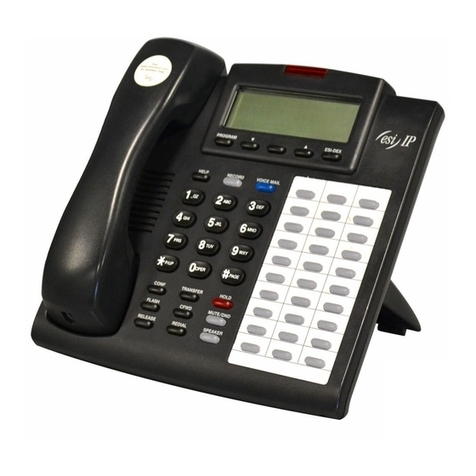
ESI
ESI Feature Phone User manual

ESI
ESI 30D Business Phone User manual
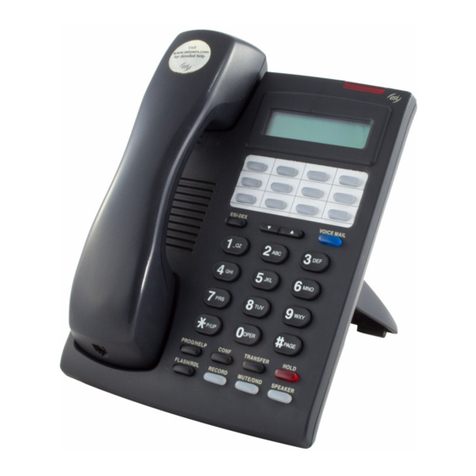
ESI
ESI Feature Phone User manual
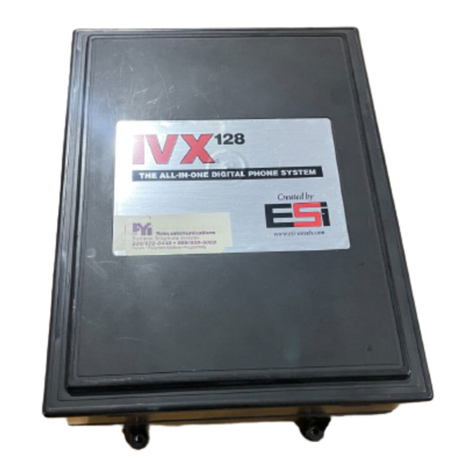
ESI
ESI IVX 128 Plus Installation and operation manual
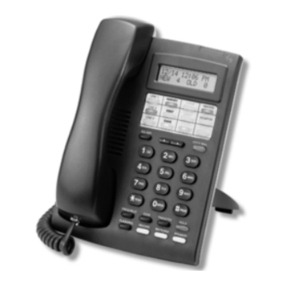
ESI
ESI 24-Key Feature Phone User manual
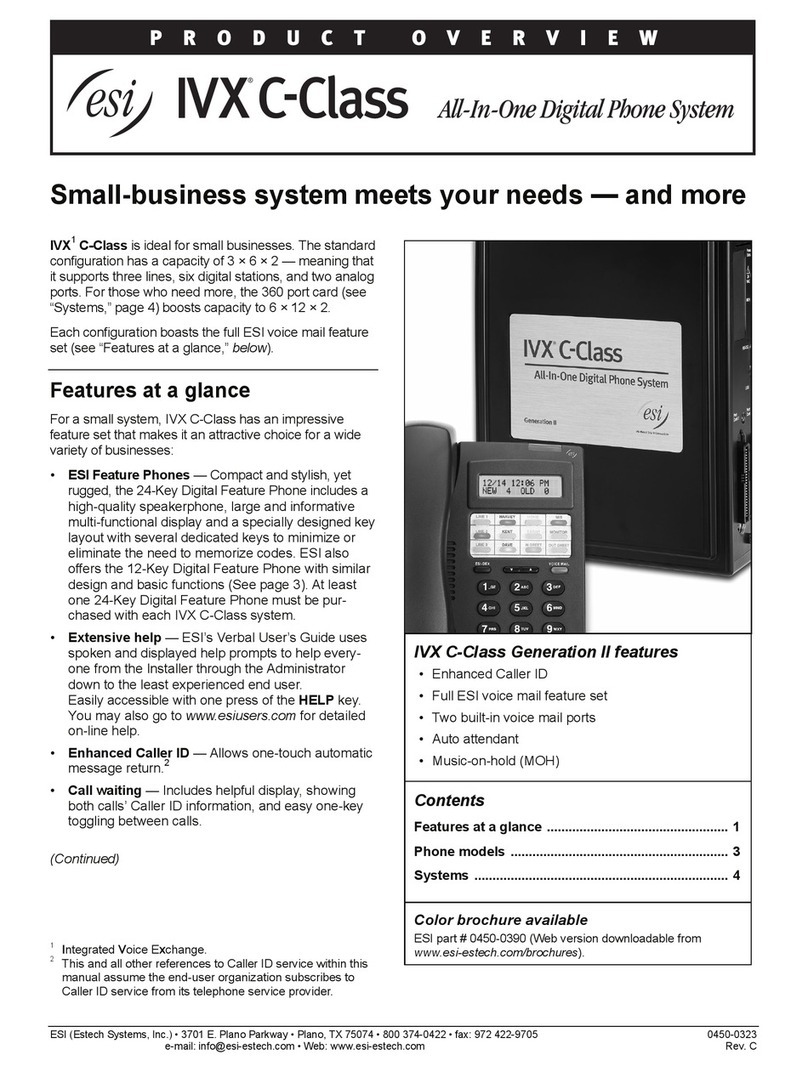
ESI
ESI IVX C-Class Operating and safety instructions
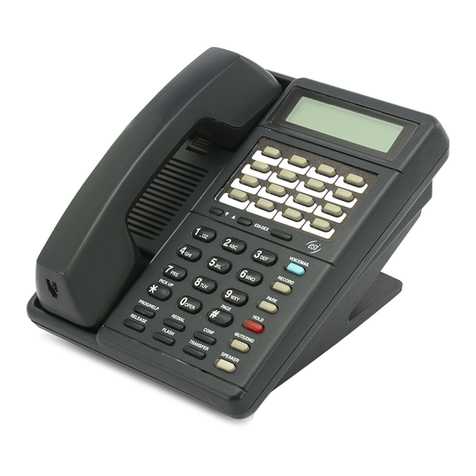
ESI
ESI IVX 20 User manual

ESI
ESI ESI Phone Specification sheet
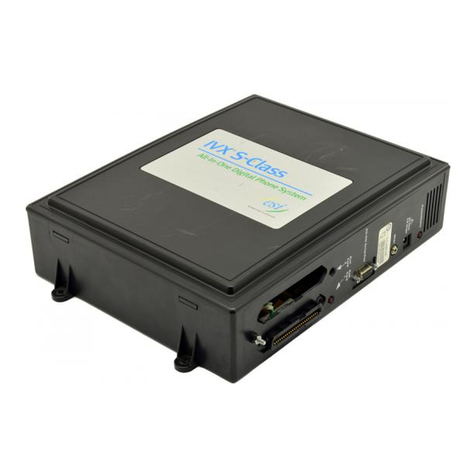
ESI
ESI IVX S-Class Use and care manual
